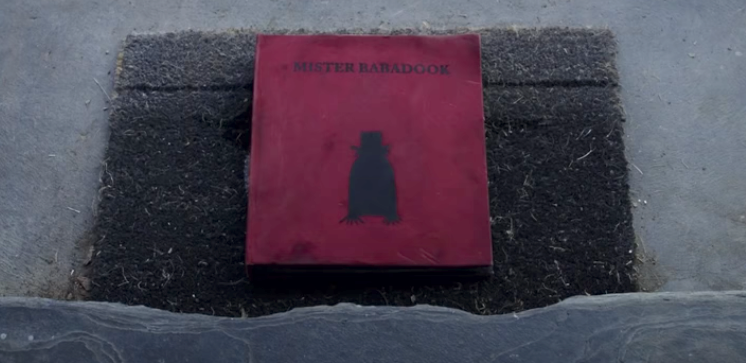
Hello, everyone. Michael Cusumano here to close out the second season of The New Classics. Since I'm wrapping it up so close to Halloween I feel like it's my duty to honor one of the 21st Century's new horror icons.
At first glance Mr. Babadook appears to be a character engineered to anchor a horror franchise. His distinctive silhouette, with his spidery claws and wardrobe right out of Dr. Caligari’s cabinet, seems ready-made for branding. It’s only once you’ve been through the psychological wringer of Jennifer Kent’s The Babadook that you realize how ill-suited the character is to such a role. The Babadook is a single serving tormentor, tailored specifically to the psychological scars of Essie Davis’s Amelia. He could no more pick up and move to a different victim than Mrs. Bates could torture someone other than poor Norman.
Scene: The Book Returns...
 "dook dook dook" ...knocks on the door
"dook dook dook" ...knocks on the door
Throughout the film Kent takes standard genre tropes and makes them chillingly specific to Davis’s weary single mom. Look, for example, at the terrifying scene where the book returns after Amelia thought she had destroyed it.
The set-up is a familiar one. Increasingly spooky thing happens in haunted house. Usually the tension in these situations comes from whether the ghostly threat is real or in the main character’s mind. In Kent’s hands the demon is so intertwined with Amelia’s fraying sanity that the question becomes irrelevant. Both possibilities are equally upsetting.
Where other horror films expand outward, exploring the lore of their creature, Kent’s film moves inward, burrowing into Amelia’s point-of-view. Mr. Babadook himself has no origin story, no explanation at all really, save what’s in the book, which is so sparse it barely counts. In my It Follows article earlier this season I detailed how supernatural horror thrives on rules and now here’s The Babadook to be the exception. Kent’s tale of terror gets away with its lack of structure because its bogeyman grows so organically out of Amelia’s suffering that the monster’s rules are simply the rules of human nature. This specificity is what makes the Babadook such a durable and versatile metaphor for everything from grief to depression to the terrors of parenting.

The scene of the book’s return starts in classic horror fashion, with three ominous knocks on the door - echoing both the book’s earlier description (Dook! Dook! Dook!) and the three little pigs motif set up in the first scene. Once she discovers the book, the editing ramps up to a whirlwind of nightmare imagery. It effectively puts us in her mental state, but it also makes sure the audience doesn’t have time to get bogged down in questions of supernatural logic. Kent recognizes the real terror of the scene isn’t in the demonic presence but in seeing the darkest parts of Amelia’s subconscious laid bare.
A horror trope that never fails to irk me is the creature that can be defeated if you show you are not afraid of it. Part of my annoyance is that it feels random. A weakness belatedly tacked on to an undefeatable antagonist. But more importantly I don’t buy it because it goes against human nature. Fear is to be overcome, not eliminated. Mr. Babadook’s tastes suggest he is a much more devious student of human nature than Freddy and Pennywise. According to the book he feeds on denial not fear. (“The more you deny me the stronger I get”) It changes this element from a convenient plot device to the core of a character battling devastating depression and repressed grief.

Is it any accident that Amelie’s otherworldly persecutor comes in the form of a book, considering her career as a writer was one of the things swallowed up when she became a mother?
There are so many perfectly executed details to savor during Amelia’s brief, panicked flip through the book. Like the way the torn pages are reassembled but no tape or glue is visible, or how the final few pop-ups no longer make mechanical sense and appear to move independently, though Kent’s tight framing shrewdly denies us a definitive view. I could do a whole separate post on when and how the film employs the blood red of "The Babadook" cover - a symbol of Amelia’s suppressed rage. (Note that in the final scene Amelia is dressed in light pink. The red isn’t gone but it’s down to a manageable amount. The repressed feelings, like the Babadook itself, are under control.)
The Babadook is a notable outlier in the supernatural horror subgenre in that it has no body count to speak of. (Well, no human body count.) Unlike most movie monsters Mr. Babadook isn’t concerned with putting up big numbers. In 99% of horror films Amelia’s sister, her neighbor, the coworker with a crush, these characters would all be marked for death. Not here. Amelia is already the “final girl” at the film’s beginning. It’s one more way both The Babadook the film and the Babadook the creature are ruthlessly disciplined in their focus on Amelia.

I hope you enjoyed season two of The New Classics. Follow me on Twitter and Letterboxd.
Click here for all the episodes of The New Classics.